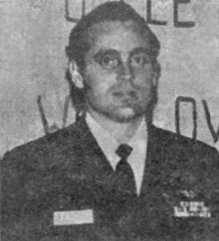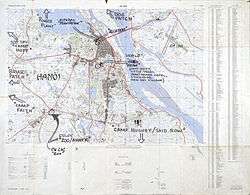Alcatraz Gang
Coordinates: 21°1′31″N 105°50′47″E / 21.02528°N 105.84639°E

The Alcatraz Gang was a group of eleven American prisoners of war (POW) held separately in Hanoi, North Vietnam during the Vietnam War because of their particular resistance to their North-Vietnamese military captors. These eleven POWs were: George Thomas Coker, USN; Jeremiah Denton, USN; Harry Jenkins, USN; Sam Johnson, USAF; George McKnight, USAF; James Mulligan, USN; Howard Rutledge, USN; Robert Shumaker, USN; James Stockdale, USN; Ronald Storz, USAF; and Nels Tanner, USN.[1]

These prisoners were held in solitary confinement from 25 October 1967 to 9 December 1969 at a special facility (dubbed "Alcatraz" by Commander Stockdale) in a courtyard behind the North Vietnamese Ministry of National Defense, about a mile away from Hoa Lo prison ("Hanoi Hilton"-named by Lt. Commander Schumaker, the earliest held prisoner among the eleven). The prisoners were shackled with legcuffs every night in 3-by-9-foot windowless concrete cells with the light on around the clock.[1][2][3][4][5] The eleven Americans were separated because they were leaders of the prisoners' resistance".[2] Stockdale once tried to kill himself so that the North Vietnamese could not force him to make a propaganda film. The suicide attempt failed and the film was never made.[2] Of Stockdale, Lt. Coker said "He was probably the strongest, most exemplary leader of the whole North Vietnamese POW environment".[2] Coker and McKnight were the last POWs assigned to the Alcatraz Gang, being so assigned for previous fierce resistance to their treatment and an unsuccessful escape from the Power Plant or "Dirty Bird" prison camp.[3][5] The POWs considered some things as just "mistreatment" not real torture, such as their ankles being shackled to the floor. Being hung from the ceiling by ropes, however, was considered torture.[5]
The group received special torture and were taken into torture sessions in order of rank, highest to lowest. Coker was the youngest and lowest ranking of the eleven POWs and was taken in last. He said he is still grateful for every minute the others held out. During the end of his session, something changed and the session stopped, which the POWs thought was because of a political decision from higher authorities to stop the sessions. All of the prisoners except Storz were moved to other prisons in December 1969. Storz, debilitated from sickness and untreated injuries, was left behind and died in captivity on 23 April 1970.[5]
When all the POWS were released from North Vietnam in February and March 1973 (Operation Homecoming), so much had changed back in the United States that Coker (and Commander Denton) said it was as if "...we weren't here (in America) at all. We were strangers in our own country, and we didn't like a lot of what we saw".[5] Many still have throbbing in joints from the rope torture and Coker's wife says, "In his sleep, he holds up 'the wall'".[5] Coker also said, "If you're never tested, you don't know (what you can do)".[5] Three of the ten out of eleven surviving "Alcatraz Gang" POWs including Stockdale (he was awarded the Medal of Honor in 1976), had died by November 2008. The others keep in close touch.[5]
See also
Notes
- 1 2 Stockdale 1996.
- 1 2 3 4 Adams 1992.
- 1 2 Rochester & Kiley 2007, p. 326
- ↑ Johnston 1974.
- 1 2 3 4 5 6 7 8 Kimberlin 2008.
References
- Adams, Lorraine (March 11, 1992). "Perot's Interim Partner Spent 7 1⁄2 Years As Pow". Dallas Morning News via The Seattle Times. Retrieved August 26, 2012.
He was one of the Alcatraz Gang – a group of 11 prisoners of war who were separated because they were leaders of the prisoners' resistance.
- Rochester, Stuart; Kiley, Frederick (2007). Honor Bound: American Prisoners of War in Southeast Asia, 1961–1973. Naval Institute Press. ISBN 978-1-59114-738-1. Retrieved August 26, 2012.
- Stockdale, James B. (March 26, 1996). "George Coker for Beach Schools (Letter to the Editor)". The Virginian Pilot. Landmark Communications.
- Johnston, Laurie (December 18, 1974). "Notes on People, Mao Meets Mobutu in China". The New York Times. Retrieved August 26, 2012.
- Kimberlin, Joanne (November 11, 2008). "Our POWs: Locked up for 6 years, he unlocked a spirit inside". The Virginian Pilot. Landmark Communications. pp. 12–13. Retrieved August 26, 2012.
Further reading
- Townley, Alvin (Feb 2014). Defiant: The POWs Who Endured Vietnam's Most Infamous Prison, the Women Who Fought for Them, and the One Who Never Returned. Thomas Dunne Books. ISBN 1250006538.